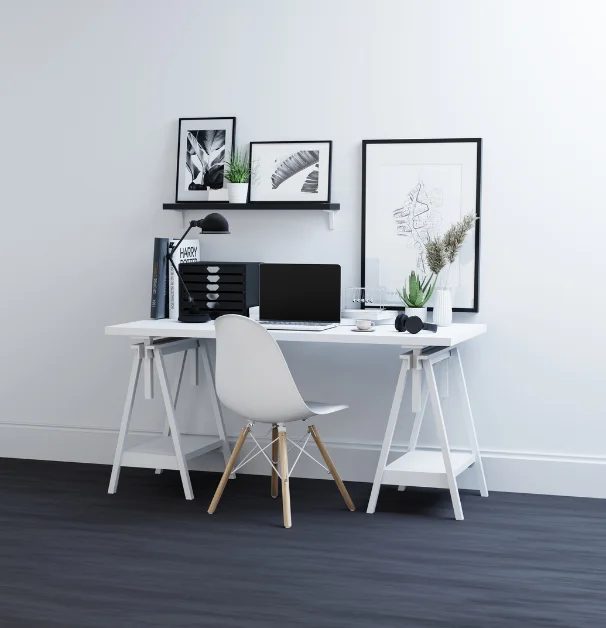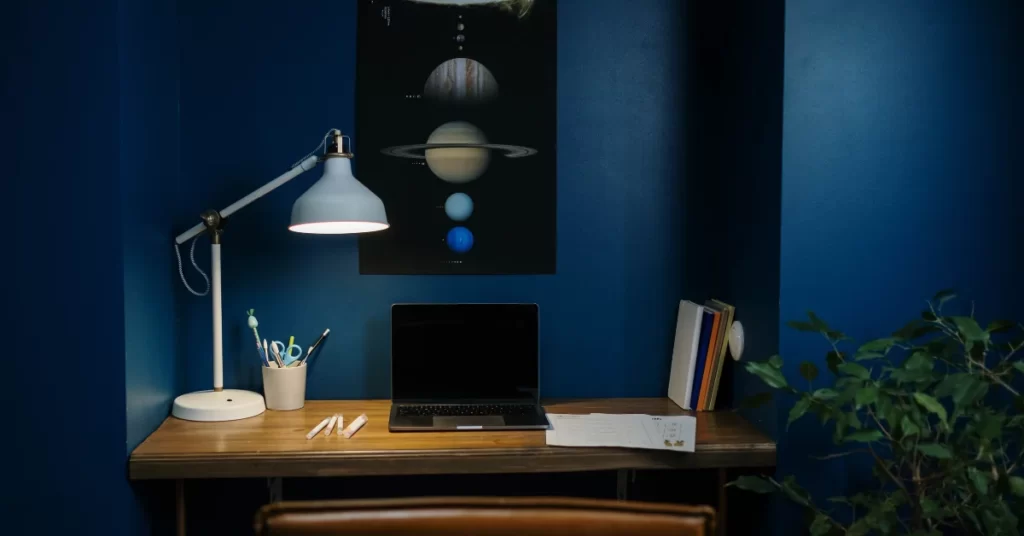Working from home has become increasingly common in recent times, and having a well-designed home office is crucial for productivity and comfort. Whether you’re a freelancer, a remote worker, or a student, creating a space that supports focus and efficiency is essential. In this blog, we’ll explore some valuable interior design tips to transform your home office into an optimal work environment.

Creating a Productive and Comfortable Home Office: Interior Design Tips for Optimal Work Environment
- Define your space:
Start by designating a specific area for your home office. Ideally, choose a quiet room or a corner that can be solely dedicated to work. This separation helps create a psychological boundary between your personal and professional life. - Lighting matters:
Natural light is the best choice for a home office as it enhances mood and productivity. Position your desk near a window to make the most of natural sunlight. Additionally, consider adding task lighting to ensure proper illumination for focused work. - Ergonomic essentials:
Invest in ergonomic furniture and accessories to support your physical well-being. A comfortable chair that provides good back support, an adjustable desk at the right height, and an ergonomic keyboard and mouse can prevent fatigue and musculoskeletal issues. - Color psychology:
Select colors that promote productivity and concentration. Blues and greens are known for their calming effects, while yellow and orange can stimulate creativity. Find the right balance that suits your work style and preferences. - Organization and storage:
Clutter can be a major distraction. Keep your home office organized with adequate storage solutions. Use shelves, cabinets, and drawers to store documents, supplies, and equipment neatly. Consider using labels and organizers to maintain order. - Noise reduction:
Minimize distractions by addressing noise issues in your home office. Use sound-absorbing materials like rugs, curtains, or acoustic panels to reduce echo and outside noise. If needed, consider using white noise machines or headphones to create a peaceful environment. - Personal touches:
Make your home office a space that reflects your personality and inspires you. Hang artwork or motivational quotes, incorporate plants for a touch of nature, or display personal mementos that bring joy and inspiration. - Technology setup:
Ensure your home office is equipped with the necessary technology. Invest in a reliable internet connection, a functional computer or laptop, and any other devices or software essential to your work. - Greenery for vitality:
Introduce indoor plants into your workspace to enhance air quality and create a soothing atmosphere. Plants such as peace lilies, snake plants, and spider plants are low-maintenance options that can thrive in an office environment. - Breakout and relaxation areas:
Designate a separate area for breaks and relaxation within your home office. This space can include a comfortable seating area, a cozy nook for reading, or a meditation corner. Taking regular breaks and having a space to unwind can boost productivity and overall well-being.
- Privacy considerations:
If your home office is located in a shared space or an open area, privacy can be a concern. Consider adding curtains, blinds, or room dividers to create a sense of privacy when needed. This will help minimize distractions and allow you to focus on your tasks. - Thoughtful desk arrangement:
Arrange your desk in a way that optimizes workflow and efficiency. Keep frequently used items within arm’s reach to minimize unnecessary movements. Place your computer monitor at eye level to prevent neck strain, and ensure your desk setup promotes good posture. - Inspiring vision board:
Create a vision board or a visual inspiration wall near your workspace. Pin up images, quotes, or goals that inspire and motivate you. This visual reminder of your aspirations can help you stay focused and driven during challenging times. - Temperature and air circulation:
Maintaining a comfortable temperature and good air circulation in your home office is vital for productivity. Ensure proper ventilation and invest in a fan, air purifier, or heater to regulate the temperature and air quality based on your needs. - Acoustic considerations:
If your work involves frequent video conferences or calls, consider acoustics in your home office design. Add sound-absorbing materials like acoustic panels or foam to minimize echoes and improve audio quality during virtual meetings. - Flexibility and adaptability:
Design your home office with flexibility in mind. Consider using modular furniture that can be easily rearranged to accommodate changing needs. This adaptability allows you to transform your workspace as required, ensuring it remains functional and efficient. - Smart storage solutions:
Make the most of your space by utilizing smart storage solutions. Install wall-mounted shelves, utilize vertical storage options, and invest in multi-functional furniture with built-in storage compartments. This will help maximize your workspace and keep it clutter-free. - Mindful wall decor:
Choose wall decor that inspires and promotes a positive mindset. Hang motivational posters, artwork, or a whiteboard for jotting down ideas and reminders. Surrounding yourself with positive imagery can enhance your mental state and foster creativity. - Prioritize comfort:
Comfort should be a top priority in your home office design. Invest in a quality ergonomic chair, add cushions or back support if needed, and ensure your desk height allows for comfortable typing and writing. An environment that supports physical comfort leads to increased productivity and reduced strain. - Regular maintenance:
Lastly, maintain your home office regularly to ensure it remains a conducive space for work. Clean your workspace, declutter regularly, and perform routine maintenance on your equipment. A well-maintained office reflects professionalism and contributes to an organized and efficient work environment.
Conclusion
By implementing these interior design tips, you can create a home office that not only enhances productivity but also provides a comfortable and inspiring environment. Remember, designing your home office is a personal process, so tailor the suggestions to your specific needs and preferences. Enjoy the process of creating a workspace that supports your work goals and helps you thrive in your professional endeavors.












